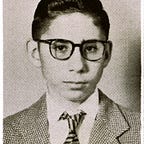Costumbrismo argentino
Costumbrismo (sometimes anglicized as Costumbrism) is the literary or pictorial interpretation of local everyday life, mannerisms, and customs, primarily in the Hispanic scene, and particularly in the 19th century.
Wikipedia
The term costumbrismo is used especially by Argentines as they have literature and music that is either unique to the city of Buenos Aires (the tango, both the classic one and Piazzolla’s) or to their provinces like their folklore (folkloric music and dance).
Some of the poems and stories of Jorge Luís Borges lose a lot in translation as many feature particularly precise Buenos Aires corners. There is lot in Borges of the loss of the Argentine and Buenos Aires of the past with the encroaching future.
I have written here how I can spot an Argentine almost anywhere in the world. There is something about their physical appearance, their clothing and of course the moment they open their mouth that accent is an instant giveaway.
It is virtually impossible for me to live a day in my present hometown of Vancouver without feeling within me the presence of the sounds, smells, literary images, etc of the country of my birth.
Many Argentines will tell you about the funky neighbourhood of La Boca and of the famous tango Caminito which is a about a little path in that Buenos Aires neighbourhood with garishly painted houses.
Few Argentines (in my family or friends) can assert that for a close to a year I worked as a waiter in one of their bars, called Paquebot Priano. Not too many Argentines can boast or at the very least admit of having been a member of the Argentine armed forces (in my case the navy as a conscript).
No young Argentines are able to talk of either of the Juan Perón eras or of having met his wife Evita (she came to my school to plant a tree).
Not too many Argentines in my social circle participated directly in a military coup d’etat that ousted a honestly elected president, Illía as I did.
And none of my friends or family met as I did Julio Cortázar who was a friend of my father’s.
What I am driving at is that I am a living case of Argentine costumbrismo. I fell in love with a an Argentine girl at an Astor Piazzola concert on Calle Florida (Teatro Florida). As a young boy I went up the Paraná River (with my mother, uncle, aunt and first cousin) in a lazy paddle wheel steamer. We could see the crocodiles. We swam on the Río Corrientes as soon as an estancia worker splashed the river bank with a horse to scare away the piranhas. We indulged in huge asados (barbecues with sheep and cows on spits) and ate cakes made with South American ostrich eggs. In fact I rode horses on the pampa galloping after the fleet footed birds.
It is for all the above that I am unable to live a day without reading a Borges poem and of late listening to Piazzolla and remembering a beautiful girl of my youth (she died long ago).
My pièce de résistance can be heard in these two tunes. One is by Argentine pianist Daniel Barenboin playing Alberto Ginastera’s La Dansa Para La Moza Donosa and the other Tina (in honour of Argentina) played on the piano by Duke Ellington.
The former while not being a tango to me aches of the sounds of my city. The other, in spite of everything (it is jazz after all!) is delightful and if I had never heard of it before I would ID it a sound of Buenos Aires.
Originally published at blog.alexwaterhousehayward.com.
